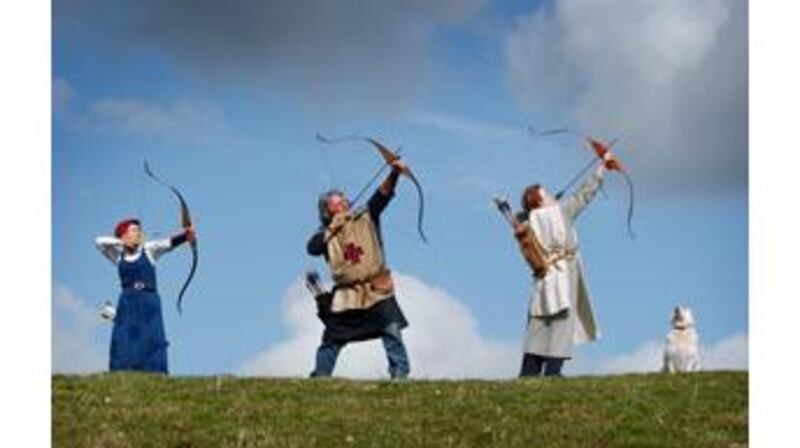... then you might just bump into a band of merry men (and women). John Byrne meets some traditional field archers on a shoot in Co Longford.
Not a lot of people know this, but the provenance of the rude, two-fingered gesture comes from the world of archery. Legend claims that in 1415, the French were lining out against the British at the battle of Agincourt. Noticing that their opponents were miserable, starving and outnumbered, the French began to feel a bit cocky. "Les Rosbifs" they surmised, "will soon be licking our boots and begging for mercy."
So confident were they of victory, they let it be known that any English archers unfortunate enough to fall into their hands would have their middle and index fingers chopped off - thus rendering it impossible to draw a long bow ever again. However, there was a massive upset and the English annihilated their enemy. Delighted, they taunted the French by waving their two fingers in the air, mocking the haughty boasts of their vanquished foes.

The salute, of course, is very much in use almost 600 years later. But it may surprise you to learn that many of the other customs from that period are also alive and well. In Ireland, they are kept alive by the Irish Traditional Field Archery Society (ITFAS).
Who are they, what is field archery, and how does it compare to the boring stuff you see on the television during the Olympics? Antoinette Truman, chairperson of the Warriors of Queen Maeve - a local branch of the society - explains. "Traditional field archery is very much based around using old-style, wooden bows - we don't use modern ones at all," she says.
The Warriors of Queen Maeve meet every Sunday at the Truman home in Longford. Members are allowed to use three kinds of bow. They are: the English long bow, as featured in Braveheart, the American flat bow, used by native American tribes, and, finally, what is known as a recurve bow, which resembles an old-style Mongolian bow.
They are strung using linen, the arrows are all made of wood, and the only concessions to modernity is a bit of fibreglass on the recurve bows, to prevent them going out of shape, and the plastic "nock" at the end of the arrow. Any kind of sites, balances or other shooting aids that feature in Olympic-style target archery are strictly banned. As one members says, "It's just you and the bow."
Some might dismiss this rejection of technology as the preserve of deluded souls who think they are stuck in the middle of Sherwood Forest. There are, however, a number of reasons for choosing traditional archery over its more modern equivalent. First, the equipment is lot cheaper. Second, it seems to operate at a much less competitive level, with the emphasis on having a laugh.
One Warrior of Queen Maeve says: "There's a crowd of target archers down the road from me - but I don't go near them. They take it too seriously. I drive all the way out here - it's much better craic."
Sean Mulroy, public relations officer of ITFAS, expands on this idea. "Traditional archers tend to be hobbyists - they like making their own arrows; some people even make their own bows. It's really more a hobby than a serious sport ... If you were to attend an event with both traditional and non-traditional archers, there'd have to be a serious compromise in how the course is set up. The high-tech bows are nearly like high-powered rifles, so you're going to want to shoot really long distances with really small targets. The traditional style is more like simulated hunting."
The action takes place in a nearby Coillte forest. Participants walk around the woods in groups, and banter away while they wait their turn to shoot static targets, like golfers out for the day. And although the pictures accompanying this article feature members dressed in medieval costumes, that is a rare occasion, done only for demonstrations. The targets are either thick, cardboard rectangles with animal images attached to them, or three-dimensional, high-density foam models.
Although, strictly speaking, each outing is a competition of sorts - higher points are given for hits closer to the heart of the target - it is not really about winning. "It is a very social thing. We're always having parties," says Truman.
A member jokingly described The Warriors of Queen Maeve as "a drinking club with an archery problem." The European Traditional Field Archery Society contest takes place today and tomorrow, but this seems to be about meeting people and doing a bit of travel as much as anything else.
For anybody thinking of giving it a go, archery is not too expensive. A basic bow, a quiver and arrows costs in the region of €200. Joining ITFAS costs €25 per annum, which covers insurance, among other things, and then you pay a sub to your local club for training.
The two main clubs in Ireland are the aforementioned Warriors of Queen Maeve, and the Déisi, based in Dungarvan, Co Waterford. And the handy thing is that even though it is illegal to hunt, under any circumstances, with a bow in Ireland - you can't even get a licence to do so, as you can with a gun - owning one for the purposes of field archery is open to anybody. So you needn't worry about anybody chopping off your fingers if they find you with one.
- Photographs: Alan Betson










